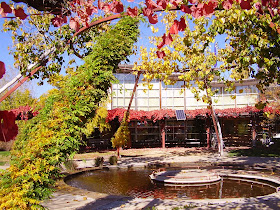
How are trees planted at the Bullocks?
ブロックスでは木を植える時に、どのような物を土に混ぜるのかを紹介します。何らかの参考になるかもしれません。
I guess the proper answer would be,
it depends! (most common answer for questions here).
It depends on where you are planting, what you are planting, when you are planting, and various other elements.

I might have mentioned it before and I probably will mention it again, for many of the trees I've planted on the homestead and for landscaping projects with Sam, we have often added:
ブロックスのちょっとした工夫。
私たちが木や多年草を植えるとき土に足すものは:
1. Water absorbing polymer crystals (top of the picture), which I have been referring to as soil gel. There are lots of "it depends" elements for its use, but for dry area tree plantings I generally put a small handful of pre-HYDRATED gel at the bottom of the hole. You would use much less if it is not pre-hydrated.
保水材:クリスタル状の保水ポリマー(写真の中心上)。使う際に考慮すべき要素はいっぱいありますが、大抵乾燥している環境で木を植える場合には、予め水分を吸収させたクリスタル(膨張しゲル状となる)を一握り穴の底に撒きます。こうする事により、長期的に安定した水分が植物に与えられ、水不足から守る事ができます。いずれは分解してなくなりますが、新しい所で健康に根付くために大切な最初の一年の間、デリケートな植物の援護をしてくれます。
Is this permaculture? Well, some might say no. Some might say, it depends on the design process and what considerations were made. Some might say, who cares what is permaculture and what isn't. I've heard the soil gel in our case referred to as a transitional technology. Something we are using for now, to speed up our development efforts and increase effectiveness, but we are not depending on it for the long term. A tractor/excavator might be another transitional technology we use. An important element here is HOW you use such technologies. This is a tricky area since we humans are skilled at rationalizing just about anything, and desire, greed, impatience can overpower the values we try to live by. I think deep reflection is essential when we employ tools and technologies, so whenever you feel like it take a moment to think about how tools and technologies affect you and the world. Just remember its not about guilt, its about healthy growth.
果たしてこれはパーマカルチャーなのでしょうか?ある人は、こんな商品を使うなんてパーマカルチャーでは無いと考えるかもしれません。またデーブみたいな人なら、パーマカルチャーであるかないかはデザイン・プロセスでどういう事が考慮されたかによると言うでしょう。「パーマカルチャーであるかないかなんてどうだってええやん」とつっこむ大阪人もいるでしょう。大切なのは使い方と状況の理解だと思います。
DiapersOne last thing about soil gel is that during the PDC one of the instructors mentioned throwing a used diaper in the planting hole. Diapers have the same or a similar product to absorb the liquids we produce. Since diapers usually go to the landfill packed with nutrients (pee and/or poop), why not give it to a tree! Yes yes, what about the plastic. Well, for one there are the "eco" biodegradable diapers and two, throwing plastic away somewhere else isn't any better for the world. So, just think of it as a soil amendment package that has a high water holding capacity and is a rich fertilizer, and its abundant and free! Ok, next.......
使い捨ておむつの技パーマカルチャー・デザインコースの講師の一人が面白いことを言っていました。保水ポリマーはおむつの中にもあるので、使用済みのおむつを穴に入れて木を植える事のお話でした。使い捨ておむつは結局ゴミになるだけですし、植物に必要な栄養素(おしっこやうんち)も含んでいます。こうする事により保水材みたいな特殊な商品を買う必要も無くなり、ゴミとしてもったいなく捨てられている物を資源に変える事ができます。最近では、自然に優しい素材(プラスチックではない)の使い捨ておむつも売られる様になってきたので、プラスチックが嫌な方も使える裏技です。近所にゴミとしてこの大切な資源をよそに捨てている家族がきっといます。おむつレスキュー隊出動!
2. Crab-meal (the white powder) I've been throwing in a small handful of this too. I mix the crab meal into the soil to spread out the concentration of nutrients just a little bit. Several of the garden beds at the homestead are also amended with crab meal each year. Someone told me our crab meal is a crab industry byproduct that comes from a factory not to far from Orcas where they process it. Down to Earth lists their crab meal as NPK 5-2-0.
蟹の甲羅の粉末(写真の中の白い粉)。これも穴に一握り撒き、土の中に軽く混ぜ込みます。ガーデンの畝にも撒く人もいます。聞いた話では、私たちが使っている蟹粉末はオーカス島の近くにある蟹肉工場の副産物らしいです。ある会社は蟹粉末をNPK 5-2-0と表示しています。
A little bit more about this nutrient, "crab meal is made by kiln-drying the shells, and then grinding them down to powder. This powder can be added to other fertilizers, lending the benefits of chitin, or the protein specific to crustacean shells. It can also be used by itself as crab meal fertilizer. The chitin provides slow release nitrogen to the plant and soil, granting the leaves deep green color and strength in its stalk fibers.
Another benefit of time-released crab meal is the protection from nematodes. Nematodes are the species of organism more commonly known as ringworm. It’s the chitin protein in the crab meal that provides this service and, as a result, your plants are parasite-free for most of its maturing, if you have used time-released crab meal." (according to DoItYourself.com http://www.doityourself.com/stry/fish-fertilizer-information-about-time-released-crab-meal)
ネットで調べた所、蟹粉末は蟹の甲羅を窯で乾燥させ、粉末状に砕いたものです。かにやエビの殻にはキチンという物質が含まれていて、窒素をゆっくりと土や植物に供給します。また、キチンは線虫を防ぐ効果があり、寄生虫のいない健康な植物を促すと書かれています。
3. MycoGrow Fungus tablets from Fungi Perfecti. According to them, "Mycorrhizal fungi are fungi that have developed a symbiotic (mutually beneficial) relationship with the root systems of living plants.....Networks of mycorrhizal filaments envelop the seedling’s root structure, supporting the plant’s own ability to utilize water and nutrients in the soil." These tablets contain 12 ecto and endomycorrhizal fungi.
I throw 1 in a hole for a bush/shrub or 2 for fruit trees. They have a recommended application chart based on the height on the tree
http://www.fungiperfecti.com/mycogrow/index.html (definitely a website worth checking out, and next time you are at the library or bookstore, I highly recommend looking through Mycelium Running by Paul Stamets (founder of Fungi Perfecti).
ファンガイ・ペルフェクタイ*(製造会社)のマイコグロー錠。商品名のMycoとはラテン語で茸、Growは英語で育てる)。Mycorrhizal Fungi(菌根菌)とは生きている植物の根と共生的(相互に有益)な関係を持つ様に進化した菌類です。これらの菌と植物は互いのニーズを満たしながら存在しています。菌の繊維状細胞ネットワークが植物の根を包み、水や栄養の利用力を強めます。各錠に12種類のEndo-(内)とEcto-(外)mycorhizal Fungiが含まれていて、その錠を果樹の穴に二つ入れています。ファンガイ・ペルフェクタイのホームページにはもっと入れる様にと説明しています。詳しくは、
http://www.fungiperfecti.com/mycogrow/index.html*ファンガイ・ペルフェクタイとは、アメリカの茸マニア(専門家)大物ポール・スタミッツ(Paul Stamets)が始めた会社で、あらゆる画期的な菌類の商品を作っており、様々な菌についての面白い研究をしている上、菌を用いて未だ未解決な環境問題の対策(bioremediation)に取り組んでいます。彼と会う事が一回あったのですが、茸を深くリスペクトしており、茸を愛してる事が感じられました。私も彼とであっていらい茸への興味が覚醒されました。また、彼の講演は新しい世界への招待状のようでした。植物、森、土、そして人間がどれだけ菌と共生してきたかはっきりと思い知らせられました。彼が書いたMycelium Running: How Mushrooms can Help Save the Worldはかなりお勧めです。写真だけでも見れば、興味がわき出すと思います。彼の環境活動は一流!
4. Sometimes we'll sprinkle some pelletized chicken manure as a top-dressing for an immediate nitrogen boost.
木を穴に植えてから鶏の糞を粒状に加工された物を撒く事もあります。植物が必要とする窒素を一時的に増やし、順調に育つ様にするために使います。
Then the usual, making a basin around the tree, watering the plant in, mulching, and putting drip irrigation. Don't forget the "it depends" clause still applies to all these techniques:)
そして、木の周りに土の輪を作ったり、水やりをしたり、マルチを敷いたり、灌水用ポリパイプをひいたりします。勿論、場合と状況によって何をやるかがかわってきます。
So, the easy thought that might come to mind is, "I'll just do it like how these guys do it," but its invaluable to come up with your own combo of amendments (or no amendments) and reasons for them based on your observation and understanding of the situation you are working with. Then you might start answering questions with, it depends.
忘れては行けない事は、植物は適切な環境にいるかぎり人間の力を必要としません。だから、土に何も入れる必要も無いし、種さえ蒔いたら勝手に育つはずです。自分の状況に最も適切な植え方を探し当ててみてください。

































